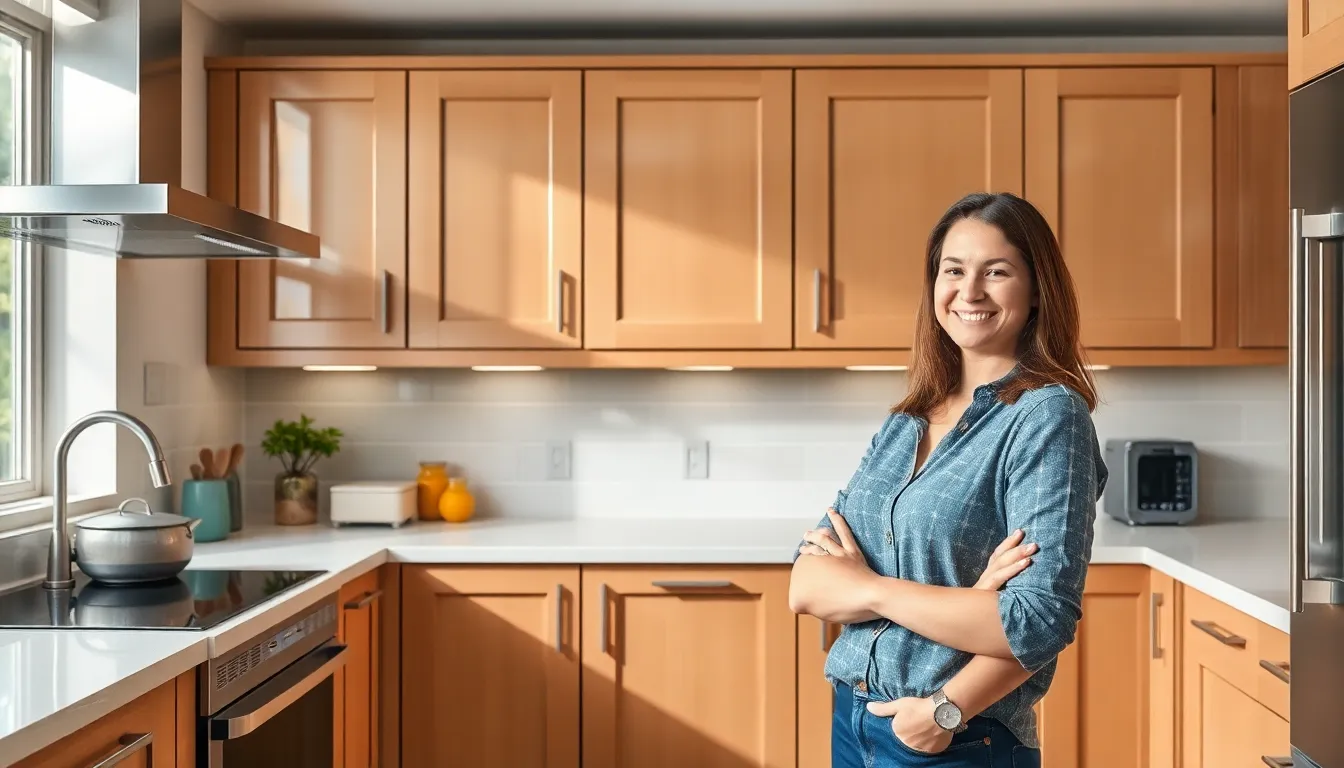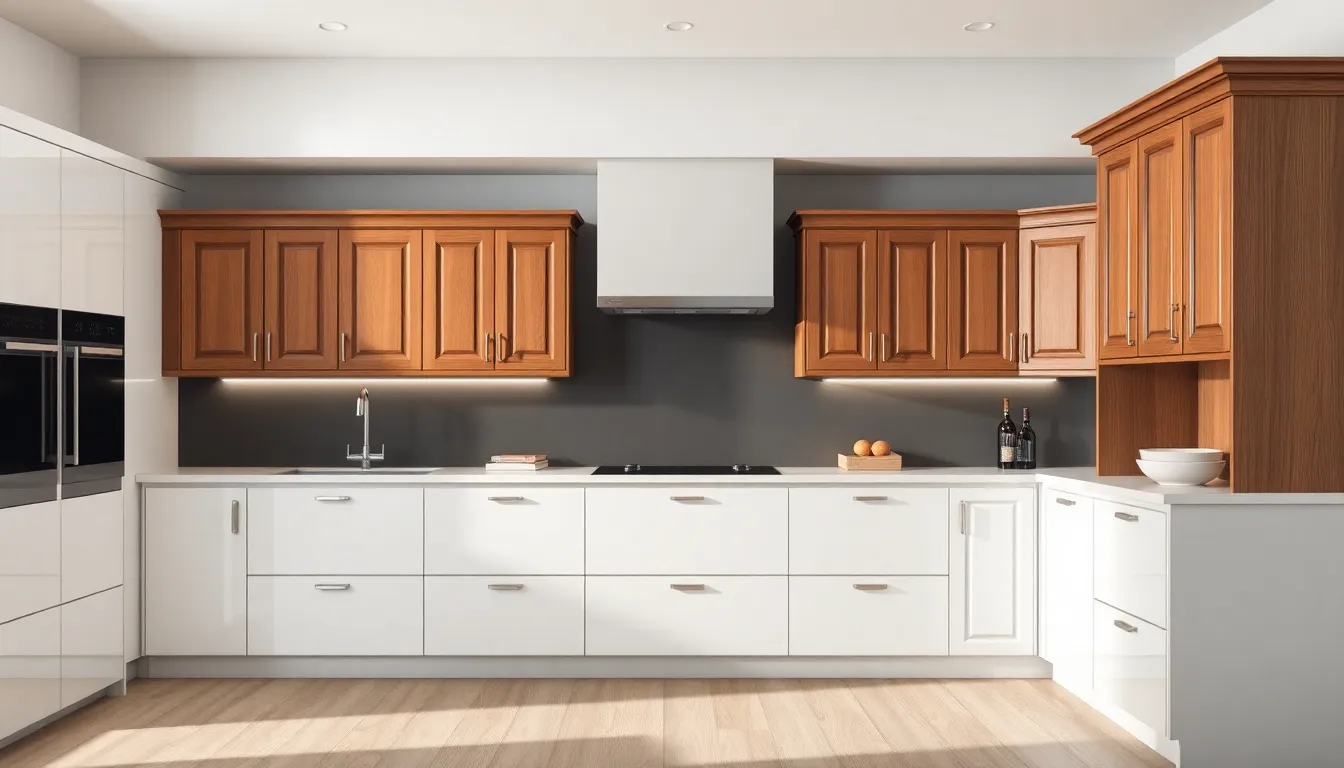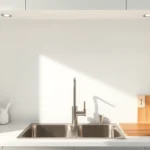
Upgrading kitchen cabinets can transform a drab cooking space into a culinary paradise. Imagine walking into a kitchen where cabinets don’t just hold your pots and pans but also showcase your personality. It’s like giving your kitchen a makeover without the need for a reality show crew.
Upgrade Kitchen Cabinets
Upgrading kitchen cabinets enhances both the aesthetic appeal and functionality of the kitchen space. New cabinets offer a stylish facelift, reflecting personal taste while improving everyday use.
Benefits of Upgrading
Upgrading cabinets provides multiple advantages. Enhanced storage solutions increase efficiency. Customizations allow for tailored designs that fit specific needs. Improved materials promote durability, ensuring cabinets withstand daily wear and tear. Fresh finishes elevate the overall look, making the kitchen more inviting. Finally, modernized cabinetry features provide better organization options, streamlining cooking and cleaning processes.
Increasing Home Value
Upgraded kitchen cabinets significantly boost home value. Renovating kitchens often attracts buyers seeking modern, functional spaces. According to the National Association of Realtors, kitchen upgrades can return about 70% to 80% of the investment when selling a home. Well-designed cabinets create a positive first impression, enhancing the overall appeal at showings. They reflect a homeowner’s commitment to quality, influencing buyer perception favorably. Investing in cabinet upgrades contributes to a more competitive market position for sellers.
Choosing the Right Style

Selecting the right style for kitchen cabinets significantly influences the kitchen’s overall look. Different styles can evoke various moods, so understanding the differences is crucial.
Modern vs. Traditional
Modern cabinets showcase sleek lines and minimal ornamentation, embodying simplicity and functionality. Flat-panel designs and high-gloss finishes often characterize these styles, creating a streamlined appearance. On the other hand, traditional cabinets emphasize craftsmanship and detail, featuring raised panels and intricate moldings. These designs enhance warmth and character, appealing to those who appreciate classic aesthetics. Homeowners should consider how each style aligns with their personal taste and existing kitchen decor before making a choice.
Popular Materials
Wood, laminate, and metal rank among the most popular materials for kitchen cabinets. Solid wood cabinets offer durability and timeless beauty, with options like oak, maple, and cherry providing diverse finishes. Laminate cabinets come in various colors and patterns, offering affordability and easy maintenance. Metal cabinets, often used in modern kitchens, bring an industrial feel while ensuring longevity. Various materials fill the space with character, making the selection process vital for achieving a desired kitchen atmosphere.
DIY vs. Hiring Professionals
Choosing between DIY and hiring professionals for upgrading kitchen cabinets can significantly influence the project’s outcome. Both options offer distinct advantages and challenges.
Pros and Cons of DIY
DIY projects allow for full creative control over the kitchen cabinets. Homeowners often save money on labor costs by tackling the renovations themselves. Acquiring new skills and enjoying the satisfaction of completing a project can be rewarding. However, time investment may be substantial and complicate the process. Mistakes during installation can lead to additional expenses for corrections. Assessing one’s skill level and available time is crucial before deciding.
When to Hire a Contractor
Hiring a contractor may be beneficial for complex cabinet upgrades. Professionals bring expertise that ensures the work meets high standards. They can navigate potential challenges and guarantee proper installation, reducing the likelihood of future issues. If the project requires extensive remodeling or permits, their experience is invaluable. Contracting a professional also allows homeowners to focus on other tasks, reducing stress and ensuring a smoother overall process.
Steps to Upgrade Kitchen Cabinets
Upgrading kitchen cabinets involves a series of steps that enhance both aesthetics and functionality. Following the right process can lead to impressive transformations.
Planning and Preparation
Establishing a clear plan is crucial. Assess current cabinets and determine what changes enhance both style and utility. Measure space accurately to ensure any new components fit seamlessly. Selecting a style that complements existing decor leads to a cohesive look. Budget constraints play a key role; understanding costs helps avoid overspending. Research materials and finishes to match desired outcomes. Creating a timeline keeps the project organized and manageable.
Painting and Refinishing Options
Consider various painting and refinishing methods to revitalize cabinets. Choosing a high-quality paint or stain ensures durability and longevity. For a subtle change, opting for lighter shades can brighten the space. Darker colors might introduce elegance and sophistication. Refinishing old wood cabinets can reveal beautiful grains and textures. Applying a protective sealant after painting or refinishing extends the lifespan of the surface. Each decision impacts the overall look and feel, so explore all available options.
Installing New Hardware
Upgrading cabinet hardware provides a quick and effective enhancement. Selecting knobs and pulls that align with the chosen style adds character. For modern aesthetics, sleek metal fixtures work well. Traditional designs might benefit from ornate options. Properly measuring and positioning new hardware ensures functionality and appearance are maximized. Replacing old hinges with soft-close versions improves everyday use while enhancing durability. Each detail contributes to the kitchen’s overall transformation.
Maintaining Your Upgraded Cabinets
Maintaining upgraded cabinets is essential for preserving their beauty and functionality. Regular care ensures long-lasting appeal and performance.
Tips for Long-Lasting Care
Regular cleaning prevents buildup and preserves the finish of cabinets. Use a soft, damp cloth for daily maintenance, avoiding abrasive cleaners that can cause damage. Waxing cabinets every six months can enhance shine and protection. Ensure proper humidity levels in the kitchen to prevent warping or cracking, particularly for wooden cabinets. Identify and wipe spills immediately to prevent stains. Lastly, consider using cabinet liners to protect surfaces from scratches and moisture.
Common Issues to Avoid
Avoid excessive moisture to prevent mold or warping. Direct sunlight can fade cabinet finishes, so consider installing window treatments for protection. Skipping maintenance can lead to deterioration, making repairs costly. Overloading shelves might cause structural damage, so monitor weight limits. Using the wrong cleaning products can strip finishes, leading to discoloration and damage over time. Lastly, neglecting hardware replacement can affect functionality and give cabinets an outdated look.
Conclusion
Upgrading kitchen cabinets is a transformative step that enhances both the beauty and functionality of a home. With the right choices in style and materials homeowners can create a space that reflects their unique taste while also improving storage and organization. Whether opting for a DIY approach or hiring professionals careful planning and attention to detail are essential for a successful upgrade.
Maintaining upgraded cabinets is equally important to ensure they remain a stunning centerpiece in the kitchen for years to come. By following best practices for care and addressing common pitfalls homeowners can enjoy the benefits of their investment while increasing their home’s value. A well-executed cabinet upgrade not only elevates the kitchen but also enriches the overall living experience.



